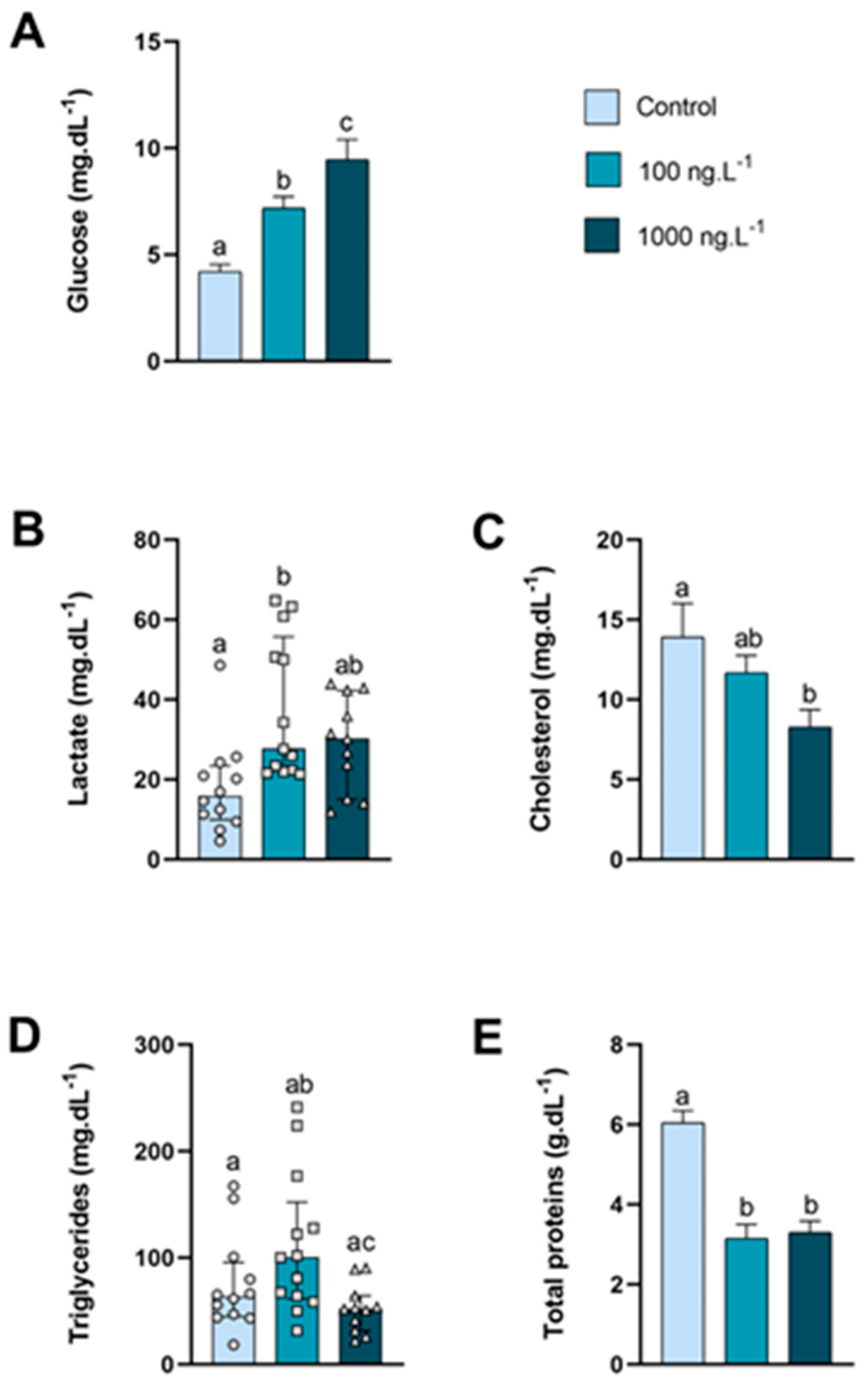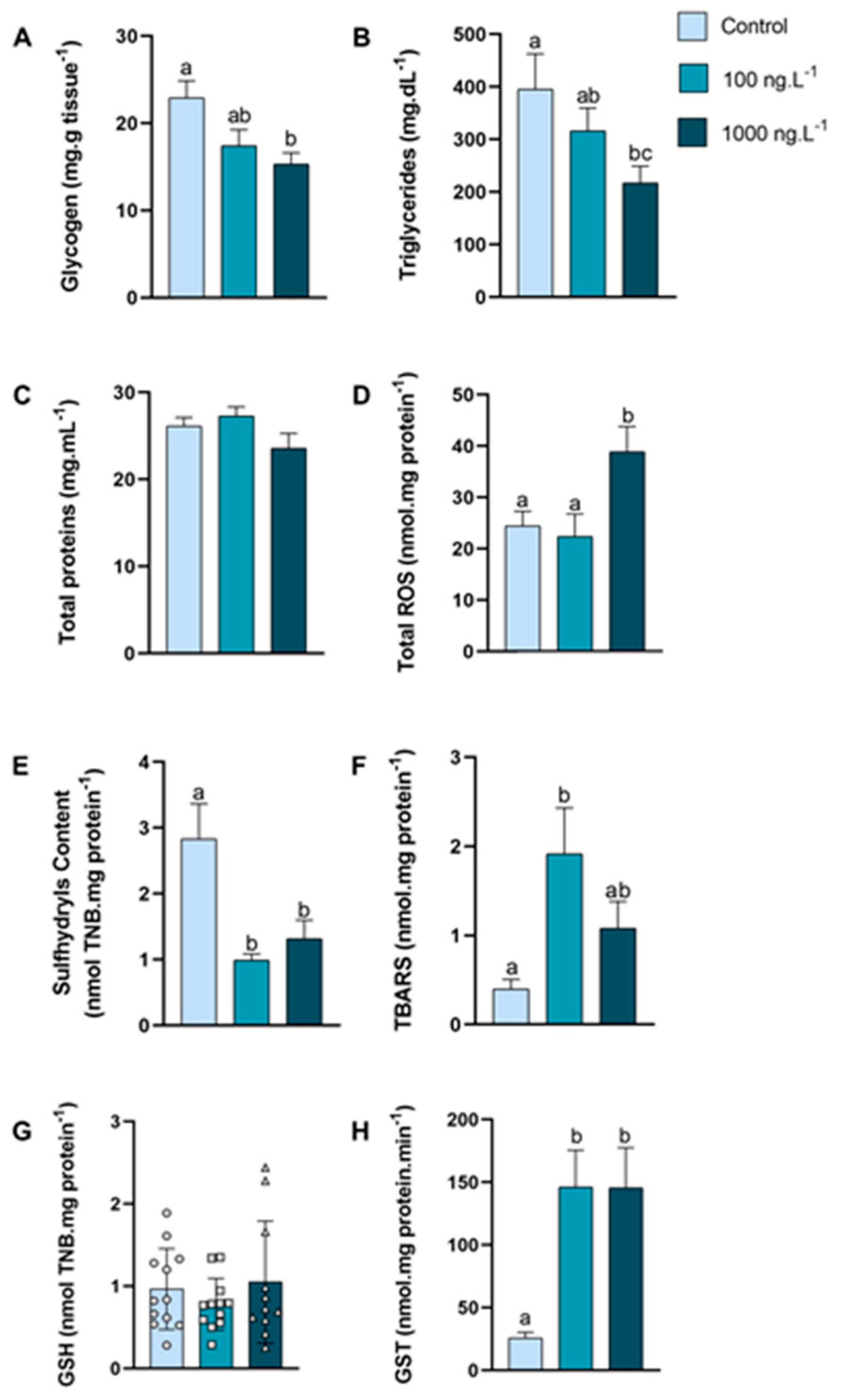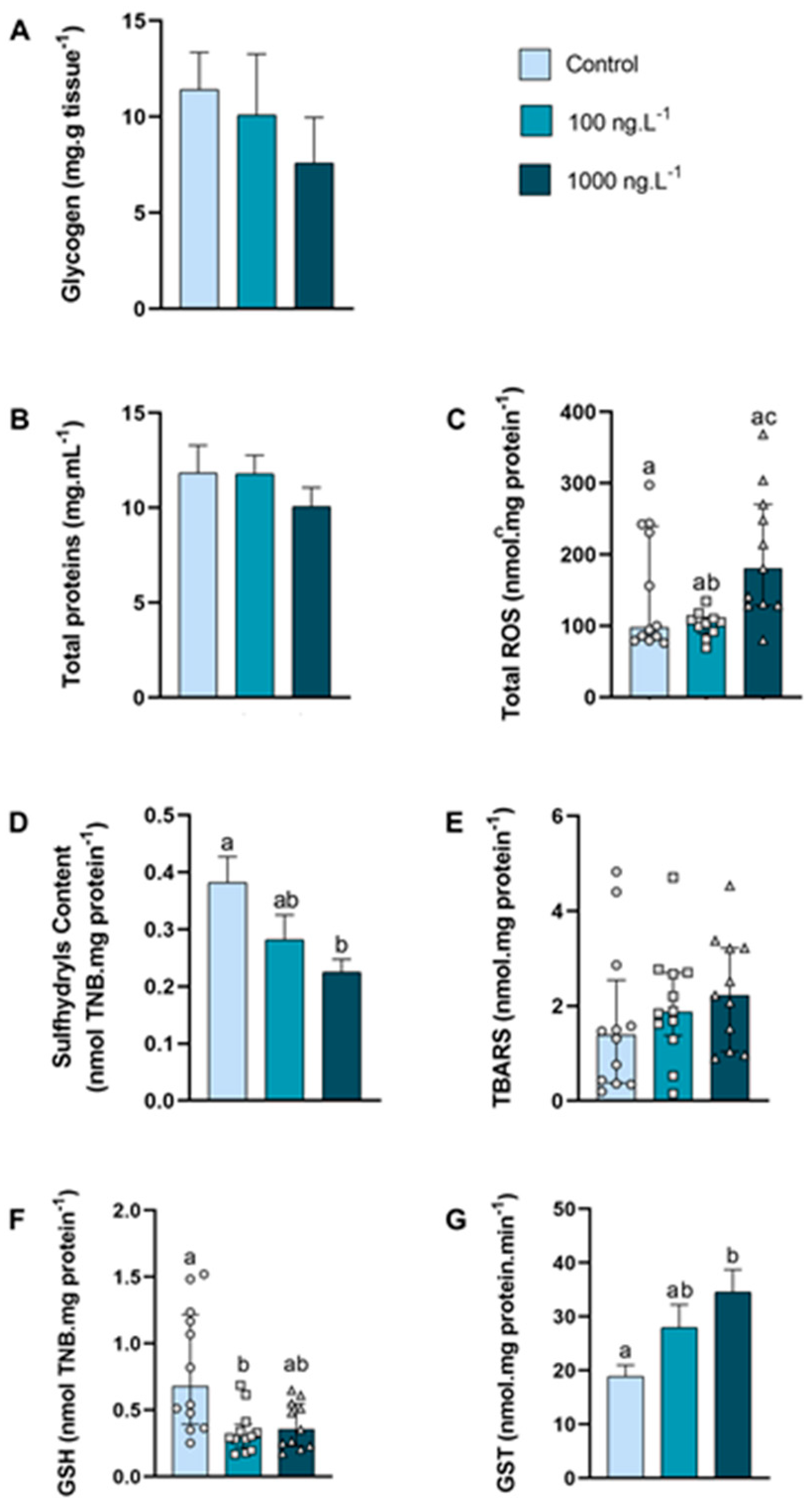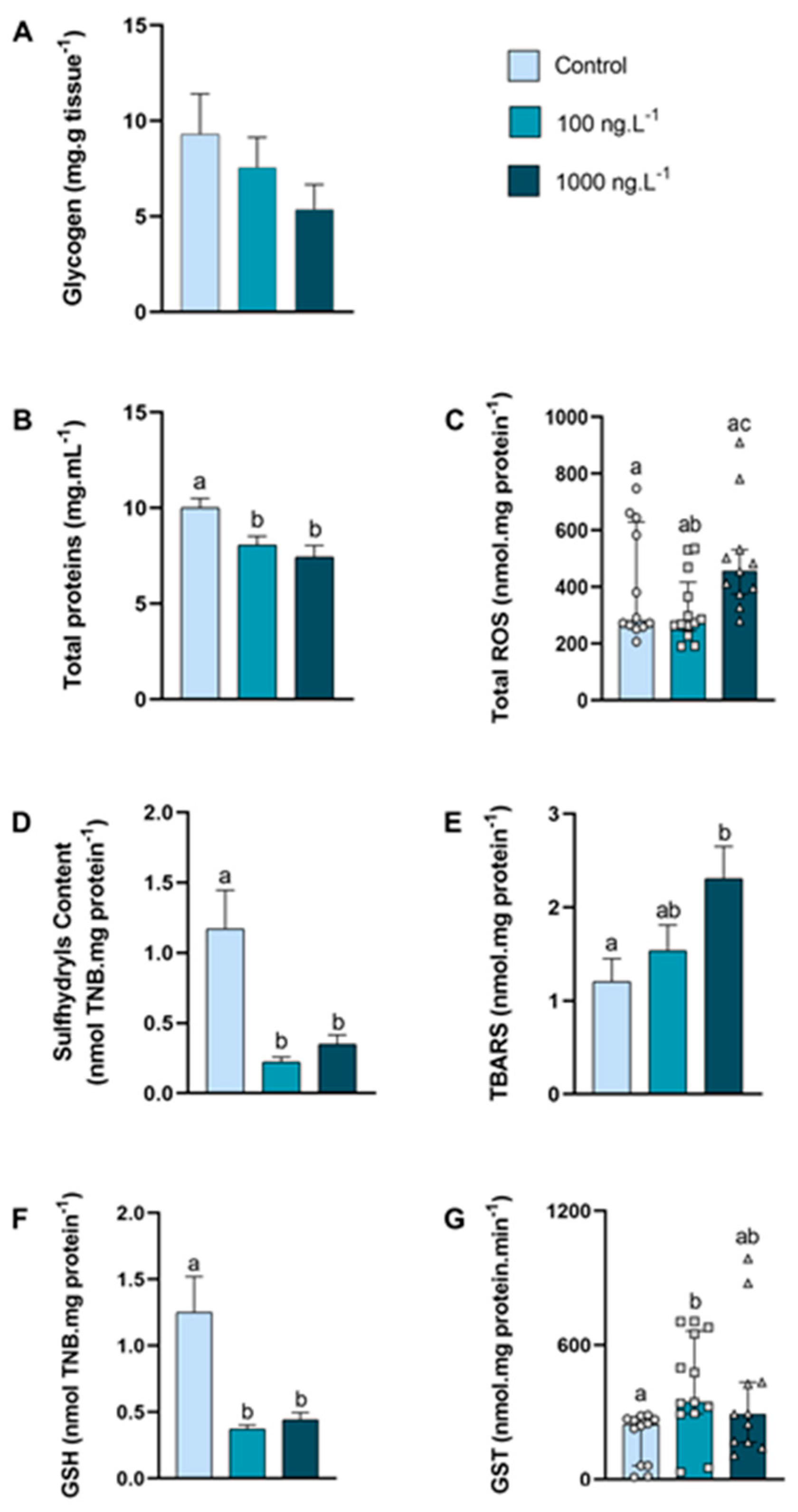Impact of Tributyltin (TBT) on Energy Metabolism and Redox Homeostasis in Blue Crab Callinectes sapidus
Abstract
:1. Introduction
2. Materials and Methods
2.1. Crab Collection, Maintenance, and Experimental Design
2.2. Biochemical Analysis
2.3. Oxidative Balance Analysis
2.4. Statistical Analysis
3. Results
3.1. Hemolymph Metabolites
3.2. Energetic Metabolism in Cardiac and Striated Muscles
3.3. The Energetic and Oxidative Metabolism in the Hepatopancreas
3.4. The Energetic and Oxidative Metabolism in the Anterior Gills
3.5. Energetic and Oxidative Metabolism in Posterior Gills
4. Discussion
5. Conclusions
Author Contributions
Funding
Institutional Review Board Statement
Informed Consent Statement
Data Availability Statement
Acknowledgments
Conflicts of Interest
Abbreviations
| OT | Organotin |
| TBT | Tributyltin |
| ROS | Reactive oxygen species |
| SOD | Superoxide dismutase |
| CAT | Catalase |
| GPx | Glutathione peroxidase |
| GST | Glutathione S-transferase |
| CHH | Crustacean hyperglycemic hormone |
| XO-SG | X organ–sinus gland |
| LPO | Lipid peroxidation |
| Total ROS | Total reactive species |
| GSH | Glutathione |
| DCFH-DA | Dichlorofluorescein diacetate |
| TBARS | Thiobarbituric acid reactive substances |
| CDNB | 1-chloro2,4-dinitrobenzene |
| MDA | Malondialdehyde |
| PAHs | Polycyclic aromatic hydrocarbons |
References
- Beyer, J.; Song, Y.; Tollefsen, K.E.; Berge, J.A.; Tveiten, L.; Helland, A.; Schøyen, M. The ecotoxicology of marine tributyltin (TBT) hotspots: A review. Mar. Environ. Res. 2022, 179, 105689. [Google Scholar] [CrossRef] [PubMed]
- Batista, R.M.; Castro, I.B.; Fillmann, G. Imposex and butyltin contamination still evident in Chile after TBT global ban. Sci. Total Environ. 2016, 566, 446–453. [Google Scholar] [CrossRef] [PubMed]
- Turk, M.F.; Ivanić, M.; Dautović, J.; Bačić, N.; Mikac, N. Simultaneous analysis of butyltins and total tin in sediments as a tool for the assessment of tributyltin behaviour, long-term persistence and historical contamination in the coastal environment. Chemosphere 2020, 258, 127307. [Google Scholar] [CrossRef] [PubMed]
- Uc-Peraza, R.G.; Delgado-Blas, V.H.; Rendón-von Osten, J.; Castro, Í.B.; Proietti, M.C.; Fillmann, G. Mexican paradise under threat: The impact of antifouling biocides along the Yucatán Peninsula. J. Hazard. Mater. 2022, 427, 128162. [Google Scholar] [CrossRef]
- Raudonytė-Svirbutavičienė, E.; Jokšas, K.; Stakėnienė, R. On the effectiveness of tributyltin ban part II: Temporal and spatial trends of organotin pollution in intense sediment accumulation areas and dumping sites of the Baltic Sea. J. Hazard. Mater. Adv. 2023, 10, 100294. [Google Scholar] [CrossRef]
- Ray, P.D.; Huang, B.W.; Tsuji, Y. Reactive oxygen species (ROS) homeostasis and redox regulation in cellular signaling. Cell. Signal. 2012, 24, 981–990. [Google Scholar] [CrossRef]
- Singaram, G.; Harikrishnan, T.; Chen, F.Y.; Bo, J.; Giesy, J.P. Modulation of immune-associated parameters and antioxidant responses in the crab (Scylla serrata) exposed to mercury. Chemosphere 2013, 90, 917–928. [Google Scholar] [CrossRef]
- Xu, Z.; Regenstein, J.M.; Xie, D.; Lu, W.; Ren, X.; Yuan, J.; Mao, L. The oxidative stress and antioxidant responses of Litopenaeus vannamei to low temperature and air exposure. Fish Shellfish Immunol. 2018, 72, 564–571. [Google Scholar] [CrossRef]
- Magara, G.; Elia, A.C.; Dörr, A.J.M.; Abete, M.C.; Brizio, P.; Caldaroni, B.; Prearo, M. Metal load and oxidative stress driven by organotin compounds on rainbow trout. Environ. Sci. Pollut. Res. 2021, 28, 35012–35022. [Google Scholar] [CrossRef]
- Dash, M.K.; Rahman, M.S. Molecular and biochemical responses to tributyltin (TBT) exposure in the American oyster: Triggers of stress-induced oxidative DNA damage and prooxidant-antioxidant imbalance in tissues by TBT. Comp. Biochem. Physiol. C Toxicol. Pharmacol. 2023, 264, 109523. [Google Scholar] [CrossRef]
- Zhao, C.; Teng, X.; Yue, W.; Suo, A.; Zhou, W.; Ding, D. The effect of acute toxicity from tributyltin on Liza haematocheila liver: Energy metabolic disturbance, oxidative stress, and apoptosis. Aquat. Toxicol. 2023, 258, 106506. [Google Scholar] [CrossRef] [PubMed]
- Chen, J.; Wei, Y.; Zhou, J.; Cao, X.; Yuan, R.; Lu, Y.; Chen, X. Tributyltin-induced oxidative stress causes developmental damage in the cardiovascular system of zebrafish (Danio rerio). Environ. Res. 2024, 252, 118811. [Google Scholar] [CrossRef] [PubMed]
- Quintaneiro, C.; Ranville, J.; Nogueira, A.J.A. Effects of the essential metals copper and zinc in two freshwater detritivores species: Biochemical approach. Ecotoxicol. Environ. Saf. 2015, 118, 37–46. [Google Scholar] [CrossRef] [PubMed]
- Strange, R.C.; Spiteri, M.A.; Ramachandran, S.; Fryer, A.A. Glutathione-S-transferase family of enzymes. Mutat. Res. Fundam. Mol. Mech. Mutagen. 2001, 482, 21–26. [Google Scholar] [CrossRef]
- Parmentier, K.F.; Verhaegen, Y.; De Witte, B.P.; Hoffman, S.; Delbare, D.H.; Roose, P.M.; Cooreman, K. Tributyltin: A bottom–up regulator of the Crangon crangon population? Front. Mar. Sci. 2019, 6, 633. [Google Scholar] [CrossRef]
- Lavradas, R.T.; Hauser-Davis, R.A.; Lavandier, R.C.; Rocha, R.C.C.; Saint’Pierre, T.D.; Seixas, T.; Moreira, I. Metal, metallothionein and glutathione levels in blue crab (Callinectes sp.) specimens from southeastern Brazil. Ecotoxicol. Environ. Saf. 2014, 107, 55–60. [Google Scholar] [CrossRef]
- Banaee, M.; Akhlaghi, M.; Soltanian, S.; Sureda, A.; Gholamhosseini, A.; Rakhshaninejad, M. Combined effects of exposure to sub-lethal concentration of the insecticide chlorpyrifos and the herbicide glyphosate on the biochemical changes in the freshwater crayfish Pontastacus leptodactylus. Ecotoxicology 2020, 29, 1500–1515. [Google Scholar] [CrossRef]
- Silva-Castiglioni, D.; Valgas, A.A.N.; Machado, I.D.; Freitas, B.S.; Oliveira, G.T. Effect of different starvation and refeeding periods on macromolecules in the haemolymph, digestive parameters, and reproductive state in Aegla platensis (Crustacea, Decapoda, Aeglidae). Mar. Freshw. Behav. Physiol. 2016, 49, 27–45. [Google Scholar] [CrossRef]
- Chang, E.S. Stressed-out lobsters: Crustacean hyperglycemic hormone and stress proteins. Integr. Comp. Biol. 2005, 45, 43–50. [Google Scholar] [CrossRef]
- Lorenzon, S. Hyperglycemic stress response in Crustacea. Invert. Surviv. J. 2005, 2, 132–141. [Google Scholar]
- Vinagre, A.S.; Trapp, M.; Kucharski, L.C.; Da Silva, R.S.M. Metabolism. In Neohelice granulata, a Model Species for Studies on Crustaceans; Cambridge Scholars Publishing: Newcastle upon Tyne, UK, 2020; Volume II, pp. 215–253. [Google Scholar]
- Chung, J.S.; Zmora, N.; Katayama, H.; Tsutsui, N. Crustacean hyperglycemic hormone (CHH) neuropeptides family: Functions, titer, and binding to target tissues. Gen. Comp. Endocrinol. 2010, 166, 447–454. [Google Scholar] [CrossRef] [PubMed]
- Simões, L.A.R.; Normann, R.S.; Chung, J.S.; Vinagre, A.S. A brief and updated introduction to the neuroendocrine system of crustaceans. Mol. Cell. Endocrinol. 2024, 590, 112265. [Google Scholar] [CrossRef] [PubMed]
- Kummer, G.; Keller, R. High-affinity binding of crustacean hyperglycemic hormone (CHH) to hepatopancreatic plasma membranes of the crab Carcinus maenas and the crayfish Orconectes limosus. Peptides 1993, 14, 103–108. [Google Scholar] [CrossRef] [PubMed]
- Menezes, E.J.; Cruz, B.P.; Martins, C.D.M.G.; Maciel, F.E. Copper exposure alters the metabolism of the blue crab Callinectes sapidus submitted to osmotic shock. Mar. Pollut. Bull. 2020, 150, 110743. [Google Scholar] [CrossRef]
- Munuera, P.; Salvat-Leal, I.; Belmonte, A.; Romero, D. Can microplastics influence the accumulation of Pb in tissues of blue crab? Int. J. Environ. Res. Public Health 2021, 18, 3599. [Google Scholar] [CrossRef]
- Simões, L.A.R.; Vogt, É.L.; da Costa, C.S.; de Amaral, M.; Hoff, M.L.M.; Graceli, J.B.; Vinagre, A.S. Effects of tributyltin (TBT) on the intermediate metabolism of the crab Callinectes sapidus. Mar. Pollut. Bull. 2022, 182, 114004. [Google Scholar] [CrossRef]
- Williams, A.B. The swimming crabs of the genus Callinectes (Decapoda: Portunidae). Fish. Bull. 1974, 72, 685–798. [Google Scholar]
- Bordon, I.C.; Sarkis, J.E.; Tomás, A.R.; Scalco, A.; Lima, M.; Hortellani, M.A.; Andrade, N.P. Assessment of metal concentrations in muscles of the blue crab, Callinectes danae S., from the Santos Estuarine System. Bull. Environ. Contam. Toxicol. 2012, 89, 484–488. [Google Scholar] [CrossRef]
- Drach, P.; Tchernigovtzeff, C. Sur le méthode de détermination des estades d’intermue et son application générale aux crustacés. Vie Milieu 1967, 18, 95–609. [Google Scholar]
- Revathi, P.; Palanisamy, I.; Lourdaraj, A.V.; Natesan, M.; Vimalananthan, A.P.; Thangaiyan, S.; Perumal, A.; Muthukalingan, K. TBT effects on the development of intersex (Ovotestis) in female freshwater prawn Macrobrachium rosenbergii. BioMed Res. Int. 2014, 2014, 412619. [Google Scholar] [CrossRef]
- Jiang, M.; Zhang, Z.; Han, Q.; Peng, R.; Shi, H.; Jiang, X. Embryonic exposure to environmentally relevant levels of tributyltin affects embryonic tributyltin bioaccumulation and the physiological responses of juveniles in cuttlefish (Sepia pharaonis). Ecotoxicol. Environ. Saf. 2023, 256, 114894. [Google Scholar] [CrossRef] [PubMed]
- Van Handel, E. Estimation of glycogen in small amounts of tissue. Anal. Biochem. 1965, 11, 256–265. [Google Scholar] [CrossRef] [PubMed]
- Geary, D. European Labour Protest; Taylor & Francis: Milton Park, UK, 1981; pp. 1848–1939. [Google Scholar]
- Inohara, E.T.S.; Pinto, C.B.; Model, J.F.A.; Trapp, M.; Kucharski, L.C.; Da Silva, R.S.M.; Vinagre, A.S. Serotonin effects in the crab Neohelice granulata: Possible involvement of two types of receptors in peripheral tissues. Comp. Biochem. Physiol. A Mol. Integr. Physiol. 2015, 185, 80–90. [Google Scholar] [CrossRef]
- Vogt, É.L.; Model, J.F.A.; Lima, M.V.; de Souza, S.K.; Rocha, D.S.; Fabres, R.B.; Vinagre, A.S. The impact of chasing stress on the metabolism of the Atlantic Ghost Crab Ocypode quadrata (Fabricius, 1787). J. Exp. Zool. A Ecol. Integr. Physiol. 2023, 339, 887–897. [Google Scholar] [CrossRef]
- Lowry, O.H.; Rosebrough, N.J.; Farr, A.L.; Randall, R.J. Protein measurement with the Folin phenol reagent. J. Biol. Chem. 1951, 193, 265–275. [Google Scholar]
- LeBel, C.P.; Ischiropoulos, H.; Bondy, S.C. Evaluation of the probe 2′,7′-dichlorofluorescin as an indicator of reactive oxygen species formation and oxidative stress. Chem. Res. Toxicol. 1992, 5, 227–231. [Google Scholar] [CrossRef]
- Sedlak, J.; Lindsay, R.H. Estimation of total, protein-bound, and nonprotein sulfhydryl groups in tissue with Ellman’s reagent. Anal. Biochem. 1968, 25, 192–205. [Google Scholar] [CrossRef]
- Esterbauer, H.; Cheeseman, K.H. Determination of aldehydic lipid peroxidation products: Malonaldehyde and 4-hydroxynonenal. Methods Enzymol. 1990, 186, 407–421. [Google Scholar] [CrossRef]
- Boyland, E.; Chasseaud, L.F. The role of glutathione and glutathione S-transferases in mercapturic acid biosynthesis. Adv. Enzymol. Relat. Areas Mol. Biol. 1969, 32, 173–219. [Google Scholar] [CrossRef]
- Kim, B.M.; Saravanan, M.; Lee, D.H.; Kang, J.H.; Kim, M.; Jung, J.H.; Rhee, J.S. Exposure to sublethal concentrations of tributyltin reduced survival, growth, and 20-hydroxyecdysone levels in a marine mysid. Mar. Environ. Res. 2018, 140, 96–103. [Google Scholar] [CrossRef]
- Vogt, É.L.; Model, J.F.; Vinagre, A.S. Effects of organotins on crustaceans: Update and perspectives. Front. Endocrinol. 2018, 9, 65. [Google Scholar] [CrossRef] [PubMed]
- Bryan, G.W.; Gibbs, P.E. Impact of low concentrations of tributyltin (TBT) on marine organisms: A review. In Metal Ecotoxicology Concepts and Applications; Taylor & Francis: Milton Park, UK, 2020; pp. 323–361. [Google Scholar]
- González, J.B.; Oliveira, E.C.; Oliveira, G.T. The impact of Roundup® Original DI on the hemolymph metabolism and gill and hepatopancreas oxidative balance of Parastacus promatensis (Crustacea, Decapoda, Parastacidae). Ecotoxicology 2024, 33, 630–641. [Google Scholar] [CrossRef] [PubMed]
- Maciel, J.E.S.; Souza, F.; Valle, S.; Kucharski, L.C.; Da Silva, R.S.M. Lactate metabolism in the muscle of the crab Chasmagnathus granulatus during hypoxia and post-hypoxia recovery. Comp. Biochem. Physiol. A Mol. Integr. Physiol. 2008, 151, 61–65. [Google Scholar] [CrossRef] [PubMed]
- Vinagre, A.S.; Model, J.F.A.; Vogt, É.L.; Manara, L.M.; Trapp, M.; Da Silva, R.S.M.; Chung, J.S. Diet composition and long-term starvation do not affect crustacean hyperglycemic hormone (CHH) transcription in the burrowing crab Neohelice granulata (Dana, 1851). Comp. Biochem. Physiol. A Mol. Integr. Physiol. 2020, 247, 110738. [Google Scholar] [CrossRef]
- Hansen, J.I.; Mustafa, T.; Depledge, M. Mechanisms of copper toxicity in the shore crab, Carcinus maenas: II. Effects on key metabolic enzymes, metabolites and energy charge potential. Mar. Biol. 1992, 114, 259–264. [Google Scholar] [CrossRef]
- Oliveira, G.T.; Da Silva, R.S. Gluconeogenesis in hepatopancreas of Chasmagnathus granulata crabs maintained on high-protein or carbohydrate-rich diets. Comp. Biochem. Physiol. A Physiol. 1997, 118, 1429–1435. [Google Scholar] [CrossRef]
- Vinagre, A.S.; Da Silva, R.S. Effects of fasting and refeeding on metabolic processes in the crab Chasmagnathus granulata (Dana, 1851). Can. J. Zool. 2002, 80, 1413–1421. [Google Scholar] [CrossRef]
- Oliveira, G.T.; Rossi, I.C.; Kucharski, L.C.; Da Silva, R.S. Hepatopancreas gluconeogenesis and glycogen content during fasting in crabs previously maintained on a high-protein or carbohydrate-rich diet. Comp. Biochem. Physiol. A Mol. Integr. Physiol. 2004, 137, 383–390. [Google Scholar] [CrossRef]
- Martins, T.L.; Chittó, A.L.F.; Rossetti, C.L.; Brondani, C.K.; Kucharski, L.C.; Da Silva, R.S. Effects of hypo- or hyperosmotic stress on lipid synthesis and gluconeogenic activity in tissues of the crab Neohelice granulata. Comp. Biochem. Physiol. A Mol. Integr. Physiol. 2011, 158, 400–405. [Google Scholar] [CrossRef]
- Sarapio, E.; Santos, J.T.; Model, J.F.A.; De Fraga, L.S.; Vinagre, A.S.; Martins, T.L.; Trapp, M. Glyceroneogenesis in the hepatopancreas of the crab Neohelice granulata: Diet, starvation and season effects. Comp. Biochem. Physiol. B Biochem. Mol. Biol. 2017, 211, 1–7. [Google Scholar] [CrossRef]
- Elumalai, M.; Balasubramanian, M.P. Influence of naphthalene on esterase activity during vitellogenesis of marine edible crab, Scylla serrata. Bull. Environ. Contam. Toxicol. 1999, 62, 743–748. [Google Scholar] [CrossRef] [PubMed]
- Vijayavel, K.; Balasubramanian, M.P. Fluctuations of biochemical constituents and marker enzymes as a consequence of naphthalene toxicity in the edible estuarine crab Scylla serrata. Ecotoxicol. Environ. Saf. 2006, 63, 141–147. [Google Scholar] [CrossRef] [PubMed]
- Revathi, P.; Iyapparaj, P.; Vasanthi, R.A.; Munuswamy, N.; Palavesam, A. Bioaccumulation of TBT and its cellular toxic effects on the freshwater prawn Macrobrachium rosenbergii. Bull. Environ. Contam. Toxicol. 2019, 103, 689–696. [Google Scholar] [CrossRef] [PubMed]
- Kharat, P.S.; Ghoble, L.B.; Shejule, K.B.; Ghoble, D.C. Effect of TBTCL on glycogen profile in freshwater prawn, Macrobrachium kistnensis. World Appl. Sci. J. 2009, 7, 1534–1539. [Google Scholar]
- Vinagre, A.S.; Chung, J.S. Effects of starvation on energy metabolism and crustacean hyperglycemic hormone (CHH) of the Atlantic ghost crab Ocypode quadrata (Fabricius, 1787). Mar. Biol. 2016, 163, 3. [Google Scholar] [CrossRef]
- Yu, N.; Ding, Q.; Li, E.; Qin, J.G.; Chen, L.; Wang, X. Growth, energy metabolism and transcriptomic responses in Chinese mitten crab (Eriocheir sinensis) to benzo [α] pyrene (BaP) toxicity. Aquat. Toxicol. 2018, 203, 150–158. [Google Scholar] [CrossRef]
- Sun, S.; Ge, X.; Zhu, J.; Fu, H.; Jiang, Z. Effects of water-borne copper on the survival, antioxidant status, metallothionein-I mRNA expression and physiological responses of the Chinese mitten crab, Eriocheir sinensis (Decapoda: Brachyura) larvae. Sci. Mar. 2014, 78, 91–97. [Google Scholar] [CrossRef]
- Walters, C.R.; Cheng, P.; Pool, E.; Somerset, V. Effect of temperature on oxidative stress parameters and enzyme activity in tissues of Cape River crab (Potamanautes perlatus) following exposure to silver nanoparticles (AgNP). J. Toxicol. Environ. Health A 2016, 79, 61–70. [Google Scholar] [CrossRef]
- Long, Z.; Shangjie, Z.; Yuyang, M.; Xinling, C.; Xiaotian, W.; Xinghong, X. Oxidative Damage of Bisphenol A to Meretrix petechialis Gill Tissues. Asian J. Ecotoxicol. 2024, 19, 223. [Google Scholar] [CrossRef]
- Yun, Y.J.; Kim, S.A.; Kim, J.; Rhee, J.S. Acute and Chronic Effects of the Antifouling Booster Biocide Diuron on the Harpacticoid Copepod Tigriopus japonicus Revealed through Multi-Biomarker Determination. J. Mar. Sci. Eng. 2023, 11, 1861. [Google Scholar] [CrossRef]
- Amiard, J.C.; Amiard-Triquet, C.; Berthet, B.; Metayer, C. Comparative Study of the Patterns of Bioaccumulation of Essential (Cu, Zn) and Non-Essential (Cd, Pb) Trace Metals in Various Estuarine and Coastal Organisms. J. Exp. Mar. Biol. Ecol. 1987, 106, 73–89. [Google Scholar] [CrossRef]
- Chou, C.L.; Paon, L.A.; Moffatt, J.D. Cadmium, Copper, Manganese, Silver, and Zinc in Rock Crab (Cancer irroratus) from Highly Copper Contaminated Sites in the Inner Bay of Fundy, Atlantic Canada. Bull. Environ. Contam. Toxicol. 2002, 68, 885–892. [Google Scholar] [CrossRef] [PubMed]
- Freire, C.A.; Onken, H.; McNamara, J.C. A Structure–Function Analysis of Ion Transport in Crustacean Gills and Excretory Organs. Comp. Biochem. Physiol. A Mol. Integr. Physiol. 2008, 151, 272–304. [Google Scholar] [CrossRef] [PubMed]
- Luquet, C.; Genovese, G.; Rosa, G.; Pellerano, G. Ultrastructural Changes in the Gill Epithelium of the Crab Chasmagnathus granulatus (Decapoda: Grapsidae) in Diluted and Concentrated Seawater. Mar. Biol. 2002, 141, 753–760. [Google Scholar] [CrossRef]
- Jaksic, Z. Mechanisms of Organotin-Induced Apoptosis. In Biochemical and Biological Effects of Organotins; Bentham Science Publishers: Sharjah, United Arab Emirates, 2012; pp. 149–163. [Google Scholar] [CrossRef]
- Dwivedi, J.; Trombetta, L.D. Acute Toxicity and Bioaccumulation of Tributyltin in tissues of Urolophus jamaicensis (Yellow Stingray). J. Toxicol. Environ. Health A 2006, 69, 1311–1323. [Google Scholar] [CrossRef]
- Henry, R.P.; Lucu, Č.; Onken, H.; Weihrauch, D. Multiple Functions of the Crustacean Gill: Osmotic/Ionic Regulation, Acid-Base Balance, Ammonia Excretion, and Bioaccumulation of Toxic Metals. Front. Physiol. 2012, 3, 431. [Google Scholar] [CrossRef]
- Wang, Y.; Jian, F.; Wu, J.; Wang, S. Stress-Response Protein Expression and DAF-16 Translocation Were Induced in Tributyltin-Exposed Caenorhabditis elegans. Bull. Environ. Contam. Toxicol. 2012, 89, 704–711. [Google Scholar] [CrossRef]
- Yi, A.X.; Han, J.; Lee, J.S.; Leung, K.M. Ecotoxicity of Triphenyltin on the Marine Copepod Tigriopus japonicus at Various Biological Organisations: From Molecular to Population-Level Effects. Ecotoxicology 2014, 23, 1314–1325. [Google Scholar] [CrossRef]
- Paital, B. Removing small non-enzymatic molecules for biochemical assay of redox regulatory enzymes; An exemplary comments on “Antioxidant responses in gills and digestive gland of oyster Crassostrea madrasensis (Preston) under lead exposure. Ecotoxicol. Environ. Saf. 2018, 154, 337–340. [Google Scholar] [CrossRef]
- Liu, N.; Wang, L.; Yan, B.; Li, Y.; Ye, F.; Li, J.; Wang, Q. Assessment of antioxidant defense system responses in the hepatopancreas of the freshwater crab Sinopotamon henanense exposed to lead. Hydrobiologia 2014, 741, 3–12. [Google Scholar] [CrossRef]
- Gamble, S.C.; Goldfarb, P.S.; Porte, C.; Livingstone, D.R. Glutathione Peroxidase and Other Antioxidant Enzyme Function in Marine Invertebrates (Mytilus edulis, Pecten maximus, Carcinus maenas, and Asterias rubens). Mar. Environ. Res. 1995, 39, 191–195. [Google Scholar] [CrossRef]
- Wu, S.; Wang, P.; Zhang, Y.; Huang, L.; Hao, Q.; Gao, L.; Huang, X. Toxicity, Oxidative Stress, and Tissue Distribution of Butachlor in the Juvenile Chinese Mitten Crab (Eriocheir sinensis). Fishes 2024, 9, 177. [Google Scholar] [CrossRef]
- Yu, Y.; Zhang, Z.; Chen, L.; Chen, Q.; Wang, Z.; Liao, X.; Li, Z.; Zhu, F.; Zhou, X. Marine Pollutant Phenanthrene (PHE) Exposure Causes Immunosuppression of Hemocytes in Crustacean Species, Scylla paramamosain. Comp. Biochem. Physiol. C Toxicol. Pharmacol. 2024, 275, 109761. [Google Scholar] [CrossRef]
- Park, M.S.; Kim, Y.D.; Kim, B.M.; Kim, Y.J.; Kim, J.K.; Rhee, J.S. Effects of Antifouling Biocides on Molecular and Biochemical Defense System in the Gill of the Pacific Oyster Crassostrea gigas. PLoS ONE 2016, 11, e0168978. [Google Scholar] [CrossRef]
- Zapata-Restrepio, L.M.; Hauton, C.; Hudson, M.D.; Williams, I.D.; Hauton, D. Toxicity of Tributyltin to the European Flat Oyster Ostrea edulis: Metabolomic Responses Indicate Impacts to Energy Metabolism, Biochemical Composition, and Reproductive Maturation. PLoS ONE 2023, 18, e0280777. [Google Scholar] [CrossRef]




| Tissue/Metabolite | Control | 100 ng/L−1 | 1000 ng/L−1 | p |
|---|---|---|---|---|
| Heart Muscle/Glycogen | 50.04 ± 12.96 | 71.49 ± 17.76 | 49.47 ± 11.05 | 0.4751 |
| Skeletal Muscle/Glycogen | 3.59 ± 3.68 | 3.57 ± 3.75 | 3.21 ± 3.21 | 0.9730 |
| Skeletal Muscle/Triglycerides | 5.58 ± 1.96 | 5.47 ± 2.06 | 5.00 ± 1.55 | 0.7389 |
Disclaimer/Publisher’s Note: The statements, opinions and data contained in all publications are solely those of the individual author(s) and contributor(s) and not of MDPI and/or the editor(s). MDPI and/or the editor(s) disclaim responsibility for any injury to people or property resulting from any ideas, methods, instructions or products referred to in the content. |
© 2025 by the authors. Licensee MDPI, Basel, Switzerland. This article is an open access article distributed under the terms and conditions of the Creative Commons Attribution (CC BY) license (https://creativecommons.org/licenses/by/4.0/).
Share and Cite
Simões, L.A.R.; Normann, R.S.; Drosdowski, D.; Selau, B.; de Amaral, M.; da Rosa Araujo, A.S.; Vinagre, A.S. Impact of Tributyltin (TBT) on Energy Metabolism and Redox Homeostasis in Blue Crab Callinectes sapidus. Metabolites 2025, 15, 253. https://doi.org/10.3390/metabo15040253
Simões LAR, Normann RS, Drosdowski D, Selau B, de Amaral M, da Rosa Araujo AS, Vinagre AS. Impact of Tributyltin (TBT) on Energy Metabolism and Redox Homeostasis in Blue Crab Callinectes sapidus. Metabolites. 2025; 15(4):253. https://doi.org/10.3390/metabo15040253
Chicago/Turabian StyleSimões, Leonardo Airton Ressel, Rafaella Sanfelice Normann, Daniela Drosdowski, Bruna Selau, Marjoriane de Amaral, Alex Sander da Rosa Araujo, and Anapaula Sommer Vinagre. 2025. "Impact of Tributyltin (TBT) on Energy Metabolism and Redox Homeostasis in Blue Crab Callinectes sapidus" Metabolites 15, no. 4: 253. https://doi.org/10.3390/metabo15040253
APA StyleSimões, L. A. R., Normann, R. S., Drosdowski, D., Selau, B., de Amaral, M., da Rosa Araujo, A. S., & Vinagre, A. S. (2025). Impact of Tributyltin (TBT) on Energy Metabolism and Redox Homeostasis in Blue Crab Callinectes sapidus. Metabolites, 15(4), 253. https://doi.org/10.3390/metabo15040253









